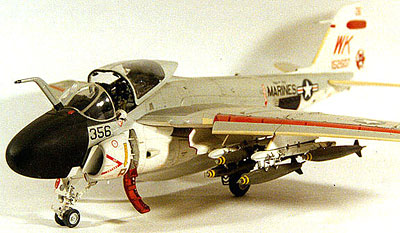1⁄35Bringing Out the Details
12
Comments
 |
You've read this article and you're ready to try this stuff out. You've opened your next kit-it's going to be your best yet right? Or maybe you got out one you just want to try this out on, that's great too. Let's say you've painted the interior parts their color and sprayed or brushed a coat of Future, clear acrylic gloss coat, or some other acrylic floor wax over it to seal in the base paint. Make your wash of dark brown or black by mixing some paint and thinner-I use an old paint jar, washed out, just to keep my wash in. Some will say take a wide brush and load it with wash and apply it over the entire area. NO! All this makes is a big muddy mess. Take a medium fine to fine brush and apply the wash only along the raised details. If you've done everything right so far when you place your brush tip in place the wash will flow along the raised detail. Don't worry if it's a little sloppy at this point-the barrier we put down over the base coat has another use later. In aircraft cockpits I generally wash on the underside or the internal structures where the shadows would be. This can get tricky when dealing with aircraft like bombers with lots of internal structures and windows. I always try to put the wash where I believe the shadows would be-opposite windows. This may also be continued on the cockpit floor and any bulkheads. Let it dry! This may take a while due to the thinness of the wash, again, be patient!
Comments
Ah, so that how you do it, eh? I guess I underestimated the importance of clear coats in washes. I tried one on my M60A2.... lets just say no one other than my parents will ever see that model again.
Now, if someone'll make an article about figure painting I'd have most of the basics covered!
YodaMan
Go Red Wings!!!
APR 25, 2002 - 08:56 PM
Interesting Article I will have to try it out. Thanks
DAGGER: A weapon with a short pointed Blade "THE CUTTING EDGE"
APR 25, 2002 - 09:21 PM
O.K., you wanted to discuss the article right?
A very nice article modelguy2, aka, Mike Taylor. Written in an easy-going style that is quite
enjoyable. I am constantly having that battle though. Enamels vs. acrylics. I like the colour availablity in the enamels (humbrol for example). But I prefer the ease and speed of the acrylics ( when I finally get the time to sit down and model, I really have to take advantage of that time).
As to washes, I used pretty much the same technique as your article discribes, sans the Q-tip. I would have another brush that was immediately handy and 'dry wipe' off any extra residue with it.
I finally discovered (after much deliberation) oil washes. I have never really 'gone back'. The richness of the oil pigments only adds to the colour variation as a whole, and the 'working time' of the oils allows a degree of control that is just simply not present in either enamels or acrylics.
Your mention of using the washes to create shadowing, especially in illustrating the 'correct' way in which a shadow would fall (away from windows) is a small, but very important point. The eye will subconciously pick up little things like that that are wrong. Good call Mike.
A well written article, difinitely prize material.
Tread.
APR 25, 2002 - 10:03 PM
That is a good article. Well done Mike. I wish that article was available about 3 or 4 months ago!
APR 25, 2002 - 10:48 PM
I updated this story with part 2 so that it would meet the contest's 1000 word requirement. Airbrushing is covered in part 2.
Jim
APR 27, 2002 - 07:04 AM
Very well written article Mike! A couple new ideas for me.
And all those models. :-)
APR 27, 2002 - 07:32 AM
Mike, a well written, well spoken, and excellent instruction of
how to use these 2 techniques, that are a must do for creating
a realistic & accurate finish on any model.
These techniques are what makes the difference between a great model
or having one with a toy like appearance - like I said, they are a "must do".
Also great models ! They show your talent & skill & are proof
of what results one can achieve by your article.
I Agree - Definitely a prize winning article !
GREAT JOB MIKE !
- ralph
MAY 18, 2002 - 03:50 PM
Yoda - Get over to my house, and I'll help you out first hand.
What do like painting with Enamels or acrylics ? - I have an excellent
article I can email you on painting faces with acrylics by Lynn Kessler.
But I myself like oils & enamels.
- ralph
MAY 18, 2002 - 03:56 PM
Good article covering the basics.Myself I use oils for all my washes as wellas drybrushing. I should add that it's on top of acrylic base coat, mainly for their longer work time and richness of color. Would love to see a comprehencive article on 1/35 figure painting
JUN 23, 2004 - 10:38 AM
Copyright ©2021 by Mike Taylor. Images and/or videos also by copyright holder unless otherwise noted. The views and opinions expressed herein are solely the views and opinions of the authors and/or contributors to this Web site and do not necessarily represent the views and/or opinions of KitMaker Network, KitMaker Network, or Silver Star Enterrpises. All rights reserved.











